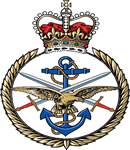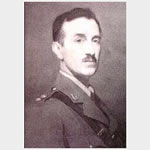Commemorated: | |||
| 1. Memorial: | Arras Memorial, Faubourg d'Amiens | Bay 1 | |
| 2. Memorial: | Freemasons VC Memorial | Great Queen Street | |
| 3. Memorial: | The (1940) Scroll - WW1 Roll of Honour | 55D GQS | |
Awards & Titles: | Victoria Cross Distinguished Service Order | ||
Family :
Son of William Spencer Watson, F.R.C.S., and Georgine Mary Jane Mair WatsonEducation & Career :
Educated at St Paul's School, London, and the Royal Military College, Sandhurst.
Service Life:
Campaigns:
- The First World War 1914-1918, World-wide.
| Unit / Ship / Est.: 2/5 King's Own Yorkshire Light Infantry |
2/5th Battalion Formed at Doncaster on 10 September 1914 as a second line unit. Record same as 2/4th Bn. 1 March 1915 : moved to Bulwell and attached to 187th Brigade in 62nd (2nd West Riding) Division. Moved in April 1915 to Strenshall and on in May to Beverley, going on in November to Gareshead, January 1916 to Larkhill and June 1916 to Flixton Park near Bungay. Moved again in October 1916 to Wellingborough. Landed at Le Havre on 15 January 1917. 2 February 1918 : absorbed into 1/5th Bn |
| Action : The First Battles of the Somme 1918 and associated actions |
21 March - 4 July 1918. The Battles of the Somme in 1918 were mostly concerned with stemming the German advance which started in March 1918 and which made considerable gains in the Somme/Arras sector. Utilising surplus troops which had become available following the surrender of Russia after the October Revolution, the Germans gambled on a massive campaign that could win the war in the west before the USA could bring its resources to bear. Initial gains were in places spectacular but eventually dogged resistance coupled with supply problems and sheer exhaustion closed down the battle. Other attacks were launched along the front to probe the Allied defences but the same pattern of initial gains followed by stalemate prevailed. British casualties were almost 345,000.
Watson was commissioned into the Green Howards from Sandhurst in 1897. He served in the Tirah Expedition 1897-8 and the China Expedition 1900. He was promoted Lieutenant in 1898 and retired in 1904. In 1909 he re-enlisted and was commissioned into the 1st County of London Yeomanry. He was promoted Lieutenant in 1911, Captain in 1913, Major in 1915, and Lieutenant-Colonel in 1918. On 28 March 1918 at Rossignol Wood, north of Hebuterne, France, a counter-attack had been made against the enemy position which at first achieved its object, but as they were holding out in two improvised strong-points, Lieutenant Colonel Watson saw that immediate action was necessary and he led his remaining small reserve to the attack, organising bombing parties and leading attacks under intense fire. Outnumbered, he finally ordered his men to retire, remaining himself in a communication trench to cover the retirement. The assault he led was at a critical moment and without doubt saved the line, but he was killed covering the withdrawal. His Victoria Cross is displayed at the Green Howards Museum (Richmond, Yorkshire, England). World War I Victoria Cross Recipient. Born in the Cavendish Square area of London, Watson was a Lieutenant Colonel posted to the 1st City of London Yeomanry, Middlesex Hussars, attached to the 5th Battalion, King's Own Yorkshire Light Infantry as Commander. Watson had previously served with 19th Bttn., Yorkshire Regiment (The Green Howards) in the Tirah Campaign (an Indian frontier war, 1897-1898) and also served in China during the Boxer Rebellion. He was awarded the on his V.C. for action at Rossignol Wood, north of Hebuterne, France, March 28, 1918, during the Kaiserschlact, the series of final, last-ditch German offensives that took place that Spring. From his citation: For most conspicuous bravery, self-sacrificing devotion to duty, and exceptionally gallant leading during a critical period of operations. His command was at a point where continual attacks were made by the enemy in order to pierce the line, and an intricate system of old trenches in front, coupled with the fact that his position was under constant rifle and machine-gun fire, rendered the situation still more dangerous. A counter-attack had been made against the enemy position, which at first achieved its object, but as they were holding out in two improvised strong points, Lt. Col. Watson saw that immediate action was necessary, and he led his remaining small reserve to the attack, organising bombing parties and leading attacks under intense rifle and machine-gun fire. Outnumbered, he finally ordered his men to retire, remaining himself in a communication trench to cover the retirement, though he faced almost certain death by so doing. The assault he led was at a critical moment, and without doubt saved the line. Both in the assault and in covering his men's retirement, he held his life as nothing, and his splendid bravery inspired all troops in the vicinity to rise to the occasion and save a breach being made in a hardly tried and attenuated line. Lt. Col. Watson was killed while covering the withdrawal. His remains were never recovered. Watson was also a recipient of the DSO (Distinguished Service Order). His medals are on display at the Green Howards Museum, Richmond, Yorkshire VCs of the First World War - Spring Offensive 1918 (Gerald Gliddon, 1997) Monuments to Courage (David Harvey, 1999) The Register of the Victoria Cross (This England, 1997)
Masonic :
| Type | Lodge Name and No. | Province/District : |
|---|---|---|
| Mother : | Loddon No. 3427 E.C. | Berkshire |
Initiated | Passed | Raised |
21st January 1911 | 18th March 1911 | 22nd April 1911 |
Source :
The project globally acknowledges the following as sources of information for research across the whole database:
- The Commonwealth War Graves Commission
- The (UK) National Archives
- Ancestry.co.uk - Genealogy, Family Trees & Family History online
- ugle.org.uk - The records of the United Grand Lodge of England including the Library and Museum of Freemasonry
Additional Source:
- Founder Researchers : Paul Masters & Mike McCarthy
- Researcher : Bruce Littley

